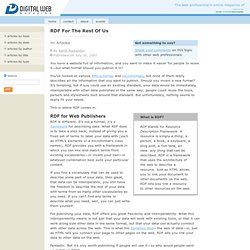

Semantic MediaWiki. AKSW : Projects / Onto Wiki. RDF For The Rest Of Us. The web professional's online magazine of choice.

In: Articles By Keith Alexander Published on July 30, 2007 You have a website full of information, and you want to make it easier for people to reuse it—but what format should you publish it in? You’ve looked at various XML schemas and microformats, but none of them really describes all the information that you want to publish. This is where RDF comes in. What is RDF? Stands for Resource Description Framework. Resource is simply a thing; a person, a book, a keyboard, a blog post, a fish tank, an idea: any thing that can be described.
RDF for Web Publishers RDF is different. If you find a vocabulary that can be used to describe some part of your data, then great, that data can be interoperable; you still have the freedom to describe the rest of your data with terms from as many other vocabularies as you need. For publishing your data, RDF offers you great flexibility and interoperability. Fantastic. RDF for Web Developers What is an RDF Triple? Why the Semantic Web Will Fail. Don't get too excited by the title.

But I do want to share a few thoughts... It was running through my head just now, the work that we were doing here in Moncton to work on an e-learning cluster. Because I saw that 'cluster building' is still one of the major pillars of NRC's strategy, and I was wondering whether our work would ever be a part of that again. And I was thinking about some of the things that didn't go so well in our first few years. Some companies went under - a couple, before we even talked to them, another, after we were in a project with them. And they weren't interested. And I thought about where we're right today and where we might be wrong, and why. And I'm saying the semantic web won't work. But how do you explain that intuition? And I was thinking about the edgy things of Web 2.0, and where they're working, and more importantly, where they're beginning to show some cracks. A few of key things today: Semantic Web.
The Semantic Web is a collaborative movement led by international standards body the World Wide Web Consortium (W3C).[1] The standard promotes common data formats on the World Wide Web.

By encouraging the inclusion of semantic content in web pages, the Semantic Web aims at converting the current web, dominated by unstructured and semi-structured documents into a "web of data". The Semantic Web stack builds on the W3C's Resource Description Framework (RDF).[2] According to the W3C, "The Semantic Web provides a common framework that allows data to be shared and reused across application, enterprise, and community boundaries".[2] The term was coined by Tim Berners-Lee for a web of data that can be processed by machines.[3] While its critics have questioned its feasibility, proponents argue that applications in industry, biology and human sciences research have already proven the validity of the original concept. History[edit] Purpose[edit] Limitations of HTML[edit] Semantic Web solutions[edit] Red-Piranha Search and Knowledge - Community Edition - Java J2EE Tomcat Lucene Xml Rdf. Gnowsis - gnowsis.